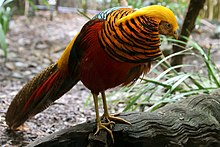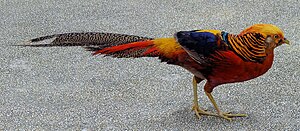| This article needs additional citations for verification. Please help improve this article by adding citations to reliable sources. Unsourced material may be challenged and removed. Find sources: "Golden pheasant" – news · newspapers · books · scholar · JSTOR (April 2019) (Learn how and when to remove this message) |
| Golden pheasant | |
|---|---|

| |
| Male golden pheasant at Melbourne Zoo | |

| |
| Female golden pheasant at Svalöv Djurpark | |
| Conservation status | |
 Least Concern (IUCN 3.1) | |
| Scientific classification | |
| Domain: | Eukaryota |
| Kingdom: | Animalia |
| Phylum: | Chordata |
| Class: | Aves |
| Order: | Galliformes |
| Family: | Phasianidae |
| Genus: | Chrysolophus |
| Species: | C. pictus |
| Binomial name | |
| Chrysolophus pictus (Linnaeus, 1758) | |
| Synonyms | |
|
Phasianus pictus Linnaeus, 1758 | |
The golden pheasant (Chrysolophus pictus), also known as the Chinese pheasant, and rainbow pheasant, is a gamebird of the order Galliformes (gallinaceous birds) and the family Phasianidae (pheasants). The genus name is from Ancient Greek khrusolophos, "with golden crest", and pictus is Latin for "painted" from pingere, "to paint".
Description

The adult male is approximately 100 cm (39 in) in length, with its tail accounting for two-thirds of the total length, and around 500–700 g (1–2 lb) in weight. Its coloration is characterized by a golden crest and rump and by a bright red body. It possess an orange ruff or "cape" on the beck that can be spread in display, appearing as an alternating black and orange fan that covers all of the face except for the eyes. The eye is bright yellow, with a pinpoint black pupil. The face, throat, chin, and the sides of neck are rusty tan. The wattles and orbital skin are both yellow. The upper back is green and the rest of the back and rump is golden-yellow. The tertiary feathers on the wings are blue, whereas the scapulars are dark red. The central tail feathers are black spotted with cinnamon, while the tip of the tail is a cinnamon buff. The upper tail coverts are the same colour as the central tail feathers. The male also has a scarlet breast, and scarlet and light chestnut flanks and underparts. Lower legs and feet are a dull yellow.
The adult female (hen) is 60–80 cm (24–31 in) in length and weights around 350 g (1 lb). Her tail is proportionally longer, and makes up roughly half of her total length. She is much less showy than the male, with a duller mottled brown plumage similar to that of the female common pheasant, but is darker and more slender. The female's breast and sides are barred buff and blackish brown, and the abdomen is plain buff. She has a buff face and throat. Some abnormal females may later in their lifetime develop some male plumage. Both males and females have yellow legs and yellow bills.
Distribution and habitat
The golden pheasant is native to forests in mountainous areas of western China, but feral populations have been established in the United Kingdom, Canada, the United States, Mexico, Colombia, Peru, Bolivia, Chile, Argentina, Uruguay, the Falkland Islands, Germany, Belgium, the Netherlands, France, Ireland, Australia and New Zealand. In England they may be found in East Anglia in the dense forest landscape of the Breckland as well as Tresco on the Isles of Scilly.
Golden pheasants were introduced to Maui, in Hawaii, at some point before their first detection in 1996. The original birds were released in The Nature Conservancy's Waikamoi Preserve, where the founder population has showed evidence of reproductive behavior. Secondary groups were later recorded in Hanawï Natural Area Reserve and Haleakalä National Park, where they most probably arrived through dispersal from Waikamoi. Overall, the pheasants inhabit areas between 1,700–2,400 m (5,577–7,874 ft) on the windward slope of the island.
Ecology
Golden pheasants feed on the ground on grain, leaves and invertebrates, but they roost in trees at night. During winter, flocks tend to forage close to human settlements at the edge of forest, taking primarily wheat leaves and seeds. While they can fly clumsily in short bursts, they prefer to run and spend most of their time on the ground. This type of flying is commonly known as "flapping flight" and is due to a lack of a deep layer of M. pectoralis pars thoracicus and the tendon that attaches to it. This muscle is commonly attributed to the stabilization of flight in other birds; however, the absence of this deep layer causes this mode of "flapping flight" is simply a mechanism that it shares with other ground birds in order to escape predators. However, they would rather prefer to simply run away and hide from their predators rather than to fly.
Golden pheasants lay 8 to 12 eggs at a time and will then incubate these for around 22–23 days. They tend to eat berries, grubs, seeds and other types of vegetation.
The male has a metallic call in the breeding season.
In captivity
The golden pheasant is commonly found in zoos and aviaries, but often as hybrid specimens that have the similar Lady Amherst's pheasant in their lineage.
There are also different mutations of the golden pheasant known from birds in captivity, including the dark-throated, yellow, cinnamon, salmon, peach, splash, mahogany and silver. In aviculture, the wild type is referred to as "red-golden" to differentiate it from these mutations.
The coloration in the feathers can be an indication to the genetic quality of the male golden pheasant. Hue, brightness, and chroma are usually measured to see color differences. results show that heterozygosity of the most polymorphic major histocompatibility complex locus was highly related with the chroma and brightness of the feathers.
Gallery
-
 Golden pheasant, egg – MHNT
Golden pheasant, egg – MHNT
-
 Female
Female
-
 Male
Male
See also
References
- BirdLife International (2018). "Chrysolophus pictus". IUCN Red List of Threatened Species. 2018: e.T22679355A131874282. doi:10.2305/IUCN.UK.2018-2.RLTS.T22679355A131874282.en. Retrieved 13 November 2021.
- Jobling, James A (2010). The Helm Dictionary of Scientific Bird Names. London: Christopher Helm. pp. 105, 306. ISBN 978-1-4081-2501-4.
- ^ Ramel, Gordon (12 July 2023). "Golden Pheasants or Chinese Pheasants, aka Red Golden Pheasant". Earthlife.net. Retrieved 3 February 2024.
- Long, John L. (1981). Introduced Birds of the World. Agricultural Protection Board of Western Australia. pp. 21–493
- Hammond, Ruby L. (April 2013). "First Successful Introduction of the Golden Pheasant (Chrysolophus pictus) to the United States". Pacific Science. 67 (2): 197–203. doi:10.2984/67.2.4. S2CID 86708497. Retrieved 3 February 2024.
- Wu, Bao-Hua, and Xiao-Ping Yu Tao Li. "Winter Diet and Digestive Tract of the Golden Pheasant (Chrysolophus Pictus) in the Qinling Mountains, China". Chinese Birds, 北京林業大學期刊編輯部, 2010, www.airitilibrary.com/Publication/alDetailedMesh?docid=16747674-201003-201109260066-201109260066-45-50.
- Zhang, Zihui; Yang, Yan (December 2013). "Forelimb Myology of the Golden Pheasant (Chrysolophus pictus)". International Journal of Morphology. 31 (4): 1482–1490. doi:10.4067/S0717-95022013000400054. ISSN 0717-9502.
| Taxon identifiers | |
|---|---|
| Chrysolophus pictus |
|